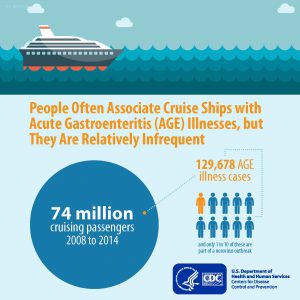Staying Healthy on a Cruise
Posted on by
The Garcia family* just booked a cruise to celebrate the college graduation of their son Angelo, and they want to make sure to have the best time possible. Mom, Tricia, has booked excursions and is double-checking her packing list to ensure they have plenty of sunscreen and clothes for their activities. Tricia excitedly shared their itinerary with her mother, Yvonne.
Yvonne replied, “That’s great, Trish. Angelo is such a smart boy. He deserves a good trip. But, how do you know you won’t get sick from norovirus?”
This worried Tricia. The last thing she wanted was for their family celebration to turn into a nightmare. What could she do to prevent or prepare for an outbreak of a contagious illness? Gail, her best friend, had been on a cruise recently and never mentioned getting sick. Plus, she always seemed to know what to do, so Tricia gave her a call. “Gail, you know we are looking forward to our upcoming cruise, but my mom has me worried that we might get sick! Did you see anyone get sick on your cruise?”

Gail laughed. “Moms are good for stirring up our fears, aren’t they? Honestly, I was concerned too. I’ve heard some terrible stories. But, we didn’t get sick. And did you know that CDC has a website where you can check a ship’s inspection scores?”
“Inspection scores? Like how restaurants are inspected?” This was new information for Tricia.
“Yes! US Public Health Service officials inspect nearly every corner of the ship from top to bottom, especially places that might affect the health of those on board, like dining rooms and kitchens, pools and spas, medical facilities, and housekeeping. And, they post the inspection reports online, so you can check the latest inspection scores and findings to see how the crew is maintaining their ship.”
As soon as Tricia hung up her phone, she searched online for “cruise ship inspection scores.” Within a few clicks, she found her ship on CDC’s website and was relieved to learn that it had recently scored a perfect 100. Tricia also found more information on the website including other ways she could protect herself and her family while on their trip. Being well prepared with information gave her confidence that this was going to be a wonderful trip.

The Facts About Outbreaks on Cruise Ships
Even though norovirus is very contagious, getting it on a cruise is fairly rare. Still, traveling on cruise ships exposes people to new environments and high volumes of people, including other travelers. This exposure can create the risk for illness from contaminated food, or water or, more commonly, through person-to-person contact. But travelers can still have a good trip by doing things to prevent illness onboard.
Follow These Tips for Healthy Cruising
- If you’re sick, report your illness.
- Before your voyage:
- Ask your cruise line if there are alternative cruising options.
- Consult a doctor to find out whether it is safe for you to sail.
- During your voyage, call the ship’s medical facility and follow the medical staff’s recommendations.
- Wash your hands often, especially after using the bathroom, touching doorknobs and railings, and before eating! Avoid exposing yourself and others to anything that may cause illnesses and spread germs.
- Take care of yourself.
- Get plenty of rest and drink plenty of water.
- Why: Resting helps rebuild your immune system. Drinking water helps prevent dehydration.
- Leave the area if you see someone get sick (vomiting or diarrhea). And, report it to cruise staff if they are not already aware.

Helping Cruise Ships and Passengers Stay Healthy
CDC’s Vessel Sanitation Program helps the cruise industry control and prevent the spread of gastrointestinal illnesses aboard cruise ships. VSP operates under the authority of the Public Health Service Act (42 U.S.C. Section 264 Quarantine and Inspection Regulations to Control Communicable Diseases). Learn more about CDC’s Vessel Sanitation Program.
VSP is part of NCEH’s Water, Food, and Environmental Health Services Branch (WFEHSB). WFEHSB, in the NCEH Division of Environmental Health Science and Practice, provides free tools and guidance, training, and research for environmental health.
*Note: This vignette is a fictional account showing how you can use CDC’s resources to stay healthy on a cruise.
Tweet this: “CDC helps cruise ships and passengers stay healthy. Learn more in our new blog at https://bit.ly/2OJy18B.”
One comment on “Staying Healthy on a Cruise”
Comments listed below are posted by individuals not associated with CDC, unless otherwise stated. These comments do not represent the official views of CDC, and CDC does not guarantee that any information posted by individuals on this site is correct, and disclaims any liability for any loss or damage resulting from reliance on any such information. Read more about our comment policy ».


Have any of the following been formalized?
1) Number of passengers allowed to sail on each cruise?
2) How is separation of individuals handled when enter the dining rooms?
3) How are passengers being separated during embarking and disembarking?
4) When visiting a port that requires the utilization of watercraft how is passenger separation to be handled onboard the smaller craft?